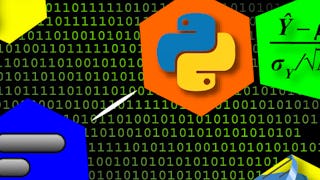How do we infer which genes orchestrate various processes in the cell? How did humans migrate out of Africa and spread around the world? In this class, we will see that these two seemingly different questions can be addressed using similar algorithmic and machine learning techniques arising from the general problem of dividing data points into distinct clusters.

Enjoy unlimited growth with a year of Coursera Plus for $199 (regularly $399). Save now.

Genomic Data Science and Clustering (Bioinformatics V)
This course is part of Bioinformatics Specialization


Instructors: Pavel Pevzner
17,088 already enrolled
Included with
(93 reviews)
Skills you'll gain
Details to know

Add to your LinkedIn profile
3 assignments
See how employees at top companies are mastering in-demand skills

Build your subject-matter expertise
- Learn new concepts from industry experts
- Gain a foundational understanding of a subject or tool
- Develop job-relevant skills with hands-on projects
- Earn a shareable career certificate

There are 3 modules in this course
<p>Welcome to class!</p><p>At the beginning of the class, we will see how algorithms for <strong>clustering </strong>a set of data points will help us determine how yeast became such good wine-makers. At the bottom of this email is the Bioinformatics Cartoon for this chapter, courtesy of <a href="http://bearandfox.com" target="_blank" title="Link: http://bearandfox.com">Randall Christopher</a> and serving as a chapter header in the Specialization's bestselling <a href="http://bioinformaticsalgorithms.com" target="_blank">print companion</a>. How did the monkey lose a wine-drinking contest to a tiny mammal? Why have Pavel and Phillip become cavemen? And will flipping a coin help them escape their eternal boredom until they can return to the present? Start learning to find out!</p><p><img width="550" alt="" src="http://bioinformaticsalgorithms.com/images/cover/clustering_cropped.jpg" title="Image: http://bioinformaticsalgorithms.com/images/cover/clustering_cropped.jpg"></p>
What's included
5 videos2 readings1 assignment2 app items
<p>Welcome to week 2 of class!</p> <p>This week, we will see how we can move from a "hard" assignment of points to clusters toward a "soft" assignment that allows the boundaries of the clusters to blend. We will also see how to adapt the Lloyd algorithm that we encountered in the first week in order to produce an algorithm for soft clustering. We will also see another clustering algorithm called "hierarchical clustering" that groups objects into larger and larger clusters.</p>
What's included
5 videos1 reading1 assignment2 app items
What's included
2 readings1 assignment
Earn a career certificate
Add this credential to your LinkedIn profile, resume, or CV. Share it on social media and in your performance review.
Instructors

Offered by
Explore more from Health Informatics
 Status: Free Trial
Status: Free TrialUniversity of Colorado Boulder
 Status: Free Trial
Status: Free TrialUniversity of London
 Status: Free Trial
Status: Free TrialJohns Hopkins University
 Status: Free Trial
Status: Free TrialUniversity of Illinois Urbana-Champaign
Why people choose Coursera for their career




Learner reviews
93 reviews
- 5 stars
50.53%
- 4 stars
27.95%
- 3 stars
11.82%
- 2 stars
3.22%
- 1 star
6.45%
Showing 3 of 93
Reviewed on Jun 9, 2017
the part about EM is the best I know, and first time I understand the EM algorithm.
Reviewed on Oct 23, 2019
Truly awesome. What I liked best was that this course didn't have a peer reviewed final challenge, so I didn't have to wait months until my work was graded :)
Reviewed on Jul 20, 2019
In depth and comprehensive coverage of the topics in genetic data analysis.

Open new doors with Coursera Plus
Unlimited access to 10,000+ world-class courses, hands-on projects, and job-ready certificate programs - all included in your subscription
Advance your career with an online degree
Earn a degree from world-class universities - 100% online
Join over 3,400 global companies that choose Coursera for Business
Upskill your employees to excel in the digital economy
Frequently asked questions
To access the course materials, assignments and to earn a Certificate, you will need to purchase the Certificate experience when you enroll in a course. You can try a Free Trial instead, or apply for Financial Aid. The course may offer 'Full Course, No Certificate' instead. This option lets you see all course materials, submit required assessments, and get a final grade. This also means that you will not be able to purchase a Certificate experience.
When you enroll in the course, you get access to all of the courses in the Specialization, and you earn a certificate when you complete the work. Your electronic Certificate will be added to your Accomplishments page - from there, you can print your Certificate or add it to your LinkedIn profile.
Yes. In select learning programs, you can apply for financial aid or a scholarship if you can’t afford the enrollment fee. If fin aid or scholarship is available for your learning program selection, you’ll find a link to apply on the description page.
More questions
Financial aid available,

